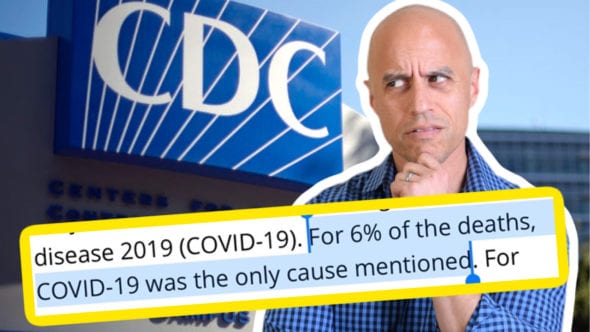How will we distinguish COVID-19 from flu and RSV in the winter? What’s the future of rapid testing? How do we prevent the next pandemic?
Dr. David Persing is the CMO/CTO of Cepheid (a leading manufacturer of rapid PCR COVID testing) and we go DEEP.
In this episode we discuss rapid PCR testing for COVID-19, influenza A and B, and RSV, as well as testing for yet-undiscovered future outbreaks like SARS-CoV3 and avian flu. We discuss rapid saliva antigen testing, why the turnaround times have been so long, what went wrong with the country’s early testing for coronavirus, and much more.
Transcript Below!
[Dr. Z] Hey, everybody, it’s Dr. Zubin Damania. Welcome to The ZDoggMD Show. All right, so I have a guest today, Dr. David Persing. He is the Chief Medical and Chief Technology Officer for Cepheid. Now, you may have heard of Cepheid recently because of COVID. They are one of the top makers of one of the most used tests for COVID-19 and the SARS-CoV-2 virus that exists right now. And full disclosure, I’ve worked with them before in a sponsored capacity, they’ve supported our show, but they’re back now because we care deeply about what they’re doing. And we have questions about testing and what’s coming this fall when a big wave of flu, RSV, and COVID is coming. Dave, welcome back to the show, man.
[Dr. Persing] Thanks, great to see you again.
[Dr. Z] So what’d I get wrong in that intro, did I miss anything?
[Dr. Persing] No, it was perfect, yeah.
[Dr. Z] The one thing I didn’t mention is that you are a master winemaker.
[Dr. Persing] Not a winemaker so much as a wine grower. So I have vines on the property and we’ll take some time later on to actually sample some of my stuff.
[Dr. Z] That is an illegal inducement of a physician, Dave. I love it, I love it so much. So here’s the thing, so when we spoke before on our show, we were talking about molecular diagnostics and we were talking about flu and TB and different things you guys have done at Cepheid. And you’re a pioneer in this because ever since being at UCSF, you’re an MD, PhD, you’ve sort of worked on this sort of molecular diagnostic angle. Now we have COVID-19 and you guys are all in the news because you make one of the major tests. Can you just fill us in, fill the audience in on how that test works and how you guys spun that up quickly?
[Dr. Persing] Sure, yeah, it was really made possible by the fact that we already had a flu test that we had developed. And so it was the same swab used for patient sampling, same transport medium, same internal workings for the cartridge, same fluidics, same extraction protocol to get the RNA out of the virus and detect it with PCR. So it was a pretty easy swap for us to basically take out the flu specific reagents and put in COVID specific reagents to make a new COVID test. And that enabled us to turn around very quickly a new test that could detect COVID very sensitively. For us, it was really important because we were designing our test for sick people, which is the way we designed our flu tests. And the importance of that is that when you have patients coming into the hospital and they’re sick, they could have any number of viruses, but if they have COVID, you really don’t want to have a false negative. You don’t want to be in the ER without PPE on, put them into a hospital room without appropriate levels of isolation and PPE use for the staff and then find out later that they’re actually COVID positive.
[Dr. Z] Yeah, so that’s a disaster, right? So what you’re talking about is sensitivity, which for the audience means a low number of false negatives, you’re catching as many cases as you can.
[Dr. Persing] Absolutely, yeah. So we felt we had to really push for the highest sensitivity possible. And that leads to what we call a high negative predictive value, which means you can have great confidence in a negative result because the test is so sensitive. So that’s what we did. And we have a test that targets two different parts of the virus. That’s important ’cause the virus can drift, can change, the genetics can drift, and you can potentially lose one target in the assay and you’d lose the ability to detect it if you had only one target in the assay, but we have two, and that makes it possible to avoid the effects of genetic drift.
[Dr. Z] Have you guys noticed drift happening within the targets that you’ve chosen, in other words, the changing targets?
[Dr. Persing] It has happened already and some of the tests out there have been affected by that drift. But we designed it so it wouldn’t be effected by that drift.
[Dr. Z] So you have this double safety of having two targets?
[Dr. Persing] Yeah.
[Dr. Z] And when you’re testing here, you’re testing for the RNA directly from viral particles?
[Dr. Persing] Yep.
[Dr. Z] So tell me about, you talked about sensitivity, so in other words, the test picks up everything that we hope is positive, but what happens when you pick up a negative but you falsely call it a positive?
[Dr. Persing] That’s a problem too. It’s actually happening, it’s in the news, you’re hearing about false positives here and there, that creates a lot of anxiety, right? Obviously for the person who is detected as positive, there’s panic, there’s a call for isolation, there’s all kinds of actions that happen after that. And there’s contact tracing which can be very-
[Dr. Z] Invasive.
[Dr. Persing] And so the bottom line is that you want to avoid both false positives and false negatives if you possibly can. So that’s what our technology is good at. It’s really good at getting a good sensitivity, but also avoiding false positives because it’s in a discreet cartridge that’s run one at a time on a per patient basis, it’s not run in big batches which can get contaminated during processing. So we avoid many of the problems associated with batch processing of specimens.
[Dr. Z] Got it, and these cartridges are similar to what you were using with flu when we talked about your flu product?
[Dr. Persing] Yeah
[Dr. Z] Yeah. And the idea is, again, since it’s not thrown in a big batch, there’s less chance of contamination. But one question I had is, so you were able to spin this up quickly because it was a transition from technology you have, so you got an emergency use authorization from FDA.
[Dr. Persing] That’s correct.
[Dr. Z] And then you were the first non-governmental entity right in the US that was providing tests.
[Dr. Persing] The first rapid test, yes, we were the first provider of a test that provided results in less than an hour.
[Dr. Z] Less than an hour?
[Dr. Persing] Yeah.
[Dr. Z] So now what’s going on now, Dave, where people are saying it’s taking a week, 10 days to get results?
[Dr. Persing] You know, it really comes down to logistics for batch testing, it comes down to the fact that these big systems have to be in a central lab, in a reference lab, so all the samples have to come to them. So you collect the specimens often in batches in a parking lot, you don’t send specimens one at a time, you send them in batches, so you gotta wait till the batch of specimens is ready then you transport those, that takes time. Then when it gets to the lab, they have to be batch processed. Depending on the level of testing that they’re doing, there could be a backlog in processing in batches. And so what we’re seeing right now is combination, I think mostly of backlogs in sample sitting in the lab waiting to be processed and that’s leading to prolonged turnaround time.
[Dr. Z] Well, so two questions. One is, is this happening with your system because yours is a cartridge system that isn’t batched?
[Dr. Persing] Well, it’s not really happening with our system because our systems are not located as often in central reference laboratories, they’re located within the hospital itself.
[Dr. Z] So directly at the point of care?
[Dr. Persing] Yeah, directly within the hospital, directly at the point of care. So the logistics are easier because the patient’s right there and the machines over there and you just walk it over to the machine, or it’s in the hospital lab or it gets transported from the emergency department or the ICU or wherever down to the stat lab, and the results get back pretty quickly.
[Dr. Z] Yeah, and I’ve seen your machines in the labs at, like, say UMC Hospital where I work and so it’s all right there, and you can do this in clinic too in smaller facilities with smaller machines, right?
[Dr. Persing] Yeah, absolutely, yeah. Yeah, there are many systems out there for point of care testing, for near patient testing. There are some restrictions in terms of how you run the test, you have to be in PPE to be able to run the test because the sample that you just collected while you were wearing PPE is still infectious so you need to process it carefully. And there are guidelines for how to do that at the point of care. So it’s not as convenient as the old days where you could just collect swab from a patient for flu testing and walk it over to a machine without concern about PPE-
[Dr. Z] Put in your teeth.
[Dr. Persing] Yeah.
[Dr. Z] And it’s like kinda lock it up right and then you throw it to the machine, right?
[Dr. Persing] Yeah, so that’s changed, but I think it’s still possible to do it on a much more decentralized spaces now.
[Dr. Z] So the follow up question, that is the bulk testing that you mentioned where it’s sitting in a lab waiting, can those samples degrade over time giving us false positive or false negative?
[Dr. Persing] That’s one of the concerns, is that the stability of the sample in the transport medium might be a factor, so there could be an advantage to running them quickly. And so we do think that could be playing into some of the false negatives that are being seen out there.
[Dr. Z] Yeah, and false negatives, the conspiracy theorists keep talking about false positives that we’re over calling everything, but then you look at excess death rate in the country and it’s through the roof. So we don’t think that’s what it is although it’s a good question ask, right? Because if hospitals are incentivized to call everything COVID, then there’s a financial incentive, but it isn’t. But so now when we’re talking about the false negatives though, because I’m seeing this happen, people with flu, with COVID symptoms, fever, body aches, feeling like they’re hit by a truck in the middle of the summer, coming back negative 10 days later when the test is finally coming back.
[Dr. Persing] Right.
[Dr. Z] Yeah.
[Dr. Persing] I mean, no test is perfect. I think one of the major challenges is that COVID can present at various stages. It can present with an early presentation of upper respiratory symptoms and fevers, body aches, very much flu like, but it can also present with lower respiratory symptoms, pneumonia likes symptoms. After some incubation period the viral infection actually transits from the upper respiratory tract to the lower respiratory tract. So it’s possible to actually, even using a very sensitive test is possible to actually miss a case by sampling the upper respiratory tract because all the action is down south in the lower tract. And so there are cases where patients have been missed because the infection is no longer as prevalent within the upper respiratory tract.
[Dr. Z] That’s really interesting because nobody’s really, not a lot of people are talking about that, and early on, we were talking about GI effects as well and should we be testing stool or doing something like that. Yeah, interesting. So just real quick before I forget and then you can follow up what you were just thinking, your test is a nasopharyngeal swab or just a nares swab?
[Dr. Persing] It’s both, nasopharyngeal swab and nasal swabs, and both are usable in the system. And that’s partly because it’s so sensitive. It does, even though the nasal viral loads are lower than the nasopharyngeal viral loads, that we still get good performance with nasal swabs.
[Dr. Z] I see, so these testing situations where they’re having people self swab their nares, do you think that’s sufficient using your technology?
[Dr. Persing] I think so, as long as the underlying technology is sensitive enough, it should be able to accommodate less invasive specimens. There are some protocols focusing on saliva now, saliva in general, depending on how it’s collected, whether you hock a loogie or not, and getting it may vary in viral load, but in general, just straight saliva doesn’t have as much virus in it as either nasal or nasopharyngeal swabs.
[Dr. Z] So, yeah.
[Dr. Persing] So, there again, a super sensitive technology can still detect it but it gets harder and harder, the further away you get from the nasopharyngeal space where the virus is replicating at maximum levels.
[Dr. Z] Got it, now relating to that, a couple of things. The first is this idea that people are retesting positive weeks and months later, what’s your thought on that, is that real, is that an artifact of the sensitivity of the test, what’s going on?
[Dr. Persing] That’s one of the big puzzles right now is what’s the meaning of a persistent, positive RNA result? Is it just an RNA fragment? Is it actively replicating virus? And the answer is we don’t fully know yet, but we suspect that after several days of infection, after several days of RNA positivity, during the peak of infection in the days following, you develop an immune response, and that simultaneously with the development of the immune response, you lose infectivity even if there’s virus still present. And so the studies are showing that use culture to actually check for infectivity of virus that between seven and 10 days after the onset of symptoms, the virus loses infectivity even though you can still detect it in the sample. So what’s the best use of a really sensitive test? It’s really for the primary diagnosis, it’s not really for monitoring infection because we don’t know what the meaning is of a test that’s run 10 days after the onset of infection relative to what’s important, which is, is the patient infectious or not.
[Dr. Z] Right, and relating to that, that’s a great explanation because people have been freaking out about this, right? Like, “Oh my God, it never goes away. “We’re getting reinfected all the time.” And I’m like, “I don’t think that means “what you think it means.” But at least we don’t know yet. And related to that, those antigen tests that Michael Mina from Harvard and others are proposing the saliva, and you mentioned saliva has a lower concentration of virus. Well, what are your thoughts on that? He’s saying, well, for a dollar a day, you can do an antigen test probably similar to the flu antigen test, rapid flu, people can do it at home and it can, you know, what’s your thought?
[Dr. Persing] My feeling is that technology will play a role because when infected people, infected patients become infected, they start off at low levels and may develop very high levels. Some may not develop high levels, but it’s quite likely that the ones who develop the highest levels of virus are the most infectious early on during the course of infection. And the antigen test will probably be capable of detecting those so-called super spreaders, the folks who really are infectious early on. They won’t detect it immediately after infection. It’ll take a couple of days for the viral antigens to build up to the point of being detected, and they’re more detected long after infection is past its primary phase, but they may be able to detect it during that window of maximal infectivity. And as a result of that, it seems like that strategy should work for asymptomatic testing. And the key is gonna be doing it often enough so that you don’t miss the window. You wanna catch it when it’s at the peak of infectivity.
[Dr. Z] And that makes sense for everything you said, which is, just a little bit beyond that peak you’re not gonna pick it up on the test, and you care about the peak because that’s when you’re actually gonna spread it to other people, so that’s when you wanna be home and maybe go get the gold standard test to confirm. So it makes a lot of sense, now you actually mentioned early on that this test that you have was really designed for sick people who are presenting, now this becomes the formative question for the fall when hospitals are gonna be overwhelmed potentially by a combination of flu, this COVID, RSV, which people stopped talking about, which is a huge, I mean, how does RSV affect the whole mix by the way ’cause no one talks about respiratory syncytial virus?
[Dr. Persing] I know, actually RSV is very important especially for the very young and very old. So RSV is well documented to cause flu like symptoms, even sepsis like presentations, severe outcomes, high mortality.
[Dr. Z] So how many deaths?
[Dr. Persing] So about 177,000 hospitalizations per year, mostly in the elderly, often in nursing home settings, and about 14,000 deaths per year. So it’s a pretty significant contributor to overall mortality, morbidity and mortality among respiratory infections especially among the elderly. So in the elderly, we’re gonna be faced with this puzzle, is it flu which causes the same problem, high morbidity and mortality in the elderly, is it RSV or is it COVID. And it’s gonna be critical to distinguish those in a nursing home setting care facilities among the elderly in general. So we felt compelled to develop a test that could actually distinguish the three major categories of virus, four different types of virus, flu A, flu B, RSV, and coronavirus, all in one test so that you could make that discrimination very quickly.
[Dr. Z] So, and this is where the rubber hits the road for clinical practitioners because the worst thing ever is trying to figure out, okay, fevers, body aches, all that. If it’s flu, it’s one treatment, it’s one set of protocols. If it’s, COVID, that’s a whole different game, including reporting. And if it’s RSV, that’s a whole different game. And so having what I would love if I were doing it in the hospital is there’s one swab and it’s got the panel, like we have respiratory panels, that kind of thing. So is that what you guys are working on? ‘Cause if so, I want that.
[Dr. Persing] That is what we’re working on. So we’ve developed a test that will address the syndromic presentation of fever, flu like symptoms, influenza like illness, ILI as they call it, that addresses flu A infection, flu B, RSV, and COVID, and they all have very similar clinical presentations of flu like illness.
[Dr. Z] Yeah, yeah. So in a single swab, it’s run on one cartridge or how does it work?
[Dr. Persing] So it’s all run on one swab that’s collected and it then extracts the RNA and it targets multiple segments of the influenza genome for flu A, also flu B, RSV, and coronavirus, and it calls them out individually as to which one it is.
[Dr. Z] And what’s the turnaround time for that test?
[Dr. Persing] Turnaround time will be 36 minutes.
[Dr. Z] That is pretty fast. So you could do it in the clinic at the point of care, patients still waiting there with a mask on making decisions or in the hospital, that’s great. So what about shortages of swab materials and bottlenecks and logistics? Is that gonna affect this?
[Dr. Persing] Yeah, I think we’re still swab dependent, right? You really can’t get a good result for flu, RSV, and coronavirus without a swab. I don’t think saliva is gonna be an option for, especially for RSV detection. There’s some evidence that you can detect flu in saliva, but we’re uncertain about whether saliva would work for RSV.
[Dr. Z] I see, and do you think you guys will have this spun-up in time for this fall season?
[Dr. Persing] We will.
[Dr. Z] That’s great.
[Dr. Persing] Yeah, it will be available for the fall season. It’ll be under an emergency use authorization, and it will be ready for the upcoming respiratory season.
[Dr. Z] That fantastic. And one of the questions then is, so at that point, would you in the fall, would you just run that panel on anyone with symptoms or would you still have the separate COVID specific swab test?
[Dr. Persing] So what we’re doing is we are making it possible for you to run the fourplex that we, inside the company, we call it fluvid, or flurvid, if you wanna include the part of the RSV part, but the fluvid test actually can be run as a standalone coronavirus test as well. So you can turn off the channels. If all you care about is coronavirus, you can turn off the flu and RSV channels and report that out separately. So it’s a versatile, it can be used for both a standalone coronavirus testing as well as for the four viruses.
[Dr. Z] And what new equipment would clinics and hospitals need to do this thing?
[Dr. Persing] They don’t need any new equipment, they use the system they already have. So it runs on the same box.
[Dr. Z] That’s fantastic. So this will be good news for people finally about testing. And then, so in terms of preparing for this pandemic in the fall, then what would you advise people? Would you say if you have our system already prepared to do this test and how do you advise people?
[Dr. Persing] Typically we’ll tell them about the test, give them some information. They can plan on bringing it in doing a short evaluation of it onsite with a system they already have. They may wanna add modules to increase their capacity if they feel they need that. We’re not sure what the flu season is gonna look like this year, it was pretty mild in Australia this year, probably because of social distancing. So we’re not sure what the pressure is gonna be for testing. We do think that a lot of people, they’re worried well with the sniffles, will wanna be tested, that could drive testing volumes even though they may not satisfy the full criteria of having flu like symptoms. So it’s just hard to gauge how many tests are gonna be run during the upcoming season.
[Dr. Z] But I imagine you’re spinning up for big demand.
[Dr. Persing] We are, in fact, the idea of making everything in one cartridge makes it easier for us to manufacture the cartridge. We don’t have to switch down lines to switch over to a new product, it makes it more efficient for us to be able to make more cartridges. And since we’re unable to meet the current demand, making more becomes important. There are a couple of design features in this test which I think help prepare us for the future. One of the big concerns is readiness for the current pandemic, but then also readiness for future pandemics.
[Dr. Z] Yeah, tell me about that.
[Dr. Persing] So there’s been a lot of concern about this new avian virus or a typical influenza, a virus in China, concerned that it might be transmissible. There’s been a lot of concern over the years about pandemic preparedness for avian influenza strains. That’s been the biggest concern over the years, has been preparing for an H1N1 2009 like pandemic but on a much larger scale. So what we’ve done with the flu part of the fluvid test is to build in not one, not two, but three independent segments being targeted within influenza A, and we built in a fourth segment to cover avian strains. So the bottom line is that we’re able to detect the full range of influenza viruses including the worst case scenario of a widespread avian strain into that, in that assay. So that really does prepare us well for the future possibility of an avian flu outbreak. It also has for the coronavirus part, it has the two targets built in for coronavirus. And one of those is a broad range target that can detect the whole family of coronaviruses that includes SARS-CoV-2. So includes everything within the bat, SARS, coronavirus family. So it will not miss a case of yet a new SARS-CoV-3 virus that were to emerge in the future. So it’s future-proofed in the sense that it’s getting us prepared for the next time this happens. And I think it’s important to consider that this could happen again.
[Dr. Z] Okay, this, if nobody listens to anything else in this interview, this is a key thing, because I’ve been telling people this is a rounding error on a real pandemic, like when something highly fatal affects children and adults equally or worse, and is spread airborne, truly like a measles type spread, we are not ready. We’re not ready for testing or therapeutics, but this can give us the early signal too because we’re going to be testing already for everything else. So if it’s part of a panel, this can be a powerful canary in the coal mine you’re seeing SARS-CoV-3, or the avian flu, like you said, and that’s tremendously powerful. So this is what we need to be thinking of now because this has been a mess. I mean, and one thing I just wanna get your opinion on is the early days of testing when things were kind of falling apart. What’s your take on all that, what happened there, early, early, early?
[Dr. Persing] Yeah, I have my own opinions about what happened, but I think that the early response included a good design by the CDC for the CDC assay, but then poor implementation. Also at the same time limiting that implementation to just the public health labs. This is early days, nobody really knew how far this was gonna spread. We thought it could be locally contained. So public health felt comfortable that enabling the local public health labs to run the test would be sufficient, but it clearly got out of control. And there was too long of a delay in allowing the private sector and reference labs in particular to offer their own versions of the same test. So reference labs were required to go through a regulatory approval process which was poorly defined early on. So they were sitting in limbo. They had an essay ready to go, just like in China and Hong Kong and South Korea, the reference labs had assays ready to go and they were available almost immediately. We had a regulatory barrier to making them available quickly. And so once that was fixed, reference labs had assays available very quickly. But by then it was even too late because testing volumes, the demand had exceeded what even they were able to handle in the private sector.
[Dr. Z] The horse was out of the barn, yeah.
[Dr. Persing] So it all came just a little bit too late. You would naturally expect that reference labs would be the first ones to offer a new assay, that’s what I did at the Mayo Clinic laboratory, was have a rapid assay available when something new hit. And then for kit manufacturers to have something after that, that would further democratize tests, they make it more available in local hospital labs. That’s the natural progression, but everything was delayed by virtue of the framework that we had to deal with early on. And I think, looking back, it would have been better if we had more of a response like South Korea to enable private labs and companies to produce reagents quickly and make them available as soon as possible.
[Dr. Z] Yeah, yeah. So, okay, so, Dave, then, do you think America ever had a shot at actually Singapore level, New Zealand level containment of this if we’d done everything right in the beginning?
[Dr. Persing] I don’t think we would be much better off at this point. I mean, I think the seating of the country on the East Coast and the West Coast, the fact that it was circulating well in advance of anybody’s awareness, the fact that there were silent carriers, asymptomatic carriers already in the population circulating the virus, we didn’t have any awareness of this early on and we had no appreciation for testing asymptomatic people, the need for that. So I don’t think it would have been much better, getting results faster and more available would have been useful but even then the public health measures that would need to be taken on a widespread basis across a wide geographic area with multiple seating events happening simultaneously, I just feel like it would not have been much different.
[Dr. Z] Yeah, yeah. Even early on, I remember looking at what China was doing in Wuhan and being like, “We can’t do that here.” It’s just not gonna happen.
[Dr. Persing] Yeah, police locked down, in America it’s just not gonna fly.
[Dr. Z] I mean, look what’s happening now, people like you and I are refusing to wear mask this is our first in person interview that I’ve done since the pandemic started and where distanced quite a few feet and have open ventilation and are wearing masks when we’re not. But a lot of people just deny that this is still a problem or our heads in the sand. And the truth is, you know, I think at this point we have to do what we can to mitigate harm and one thing that you guys are doing that is gonna be so key from everything that I’m getting from this, there’s actually two things, just to summarize for the audience and for my own thinking. The first is the four test, flu A, flu B, COVID, and RSV test, because if I’m seeing a patient who has a fever and some body aches in the fall, flu still happens, RSV still happens and it kills people and it’s a different treatment. So having a rapid test that’s 36 minutes turnarounds would actually transform my ability to manage those patients. So that’s actually a diagnostic that helps us tremendously. And the second thing is this future pandemic sort of alarm system which is adding elements to your testing that will pick up sequence homology and other coronaviruses that come from bat, in avian flu viruses that could decimate our population. So that is key that you guys are doing. And is there anything that I’m missing that you guys are bringing up right now or that’s been talked about recently?
[Dr. Persing] No, I think that’s a great summary. I think it is a critical combination of technologies. We need to be even more forward thinking about how we’ll respond in the future. So it’s great to develop a broad range, SARS bat coronavirus part. It’s great to develop a broad range flu part. But what about MERS family? We need to accommodate for that. What if that were to become more widespread, more transmissible? What about disease X? What about a nipah like virus which is a measles like virus that nearly caused a major pandemic a few years ago in India.
[Dr. Z] Oh, wow!
[Dr. Persing] Highly transmissible, high mortality rates. What if that were to happen? None of our tests would be ready for that. So how do we adapt more quickly to the emergence of disease X? How do we enable labs to be set up more quickly to be able to adapt to a brand new threat? Part of it is gonna be referenced labs, for sure. That’s what references do.
[Dr. Z] These are the bigger stable labs you send the samples to?
[Dr. Persing] Yeah, send samples to.
[Dr. Z] Right.
[Dr. Persing] But critical to that is gonna be enabling decentralized testing for disease X as well. And with our global footprint of over 25,000 systems out there in almost every country, it makes sense for us to be able to have a response to that as well.
[Dr. Z] And I think the bottom line, and this is science applied to a problem actually works if you do it correctly and learn from past mistakes. And so now you’re trying to move forward into the future with this set that’s really, I think gonna be quite helpful assuming that it’s executed well, so I’m gonna hold you accountable. You’re gonna come back in the fall and tell me how things are going then?
[Dr. Persing] Okay, I will.
[Dr. Z] I love it.
[Dr. Persing] Yeah, for sure.
[Dr. Z] I love it, I love it. We’re neighbors now in the Bay Area.
[Dr. Persing] Absolutely.
[Dr. Z] So it was fun to just have you be able to pop over and be on the show, it’s really exciting ’cause the audience is just desperate for more information on testing and there’s so much misinformation and it’s just been such a disastrous mess, but I’m glad that we have somebody there who’s at least steering a ship in the right direction. So Diamond Dave, thanks again for being back on the show.
[Dr. Persing] It is truly my pleasure.
[Dr. Z] Thanks again, and ZPac, do me a favor, this is an episode you should share with the key points that flu, RSV, COVID, are coming this fall and it’s going to be difficult if we don’t quickly and accurately diagnose them and be aware clinically that these things happen and that we have to get ready for the next pandemic, all right? And then we have to hold our leadership accountable too to provide us with the resources and the tools like this, and the logistics to support it, the swab production, all of that, that keep us ready for this kind of thing because without that, the best science is gonna fall flat ’cause you can’t execute it. So thanks again again to Dave Persing from Cepheid, and thanks to you guys for sharing the episode and we out, peace.
Category
- The ZDoggMD Show (818)
- Featured Videos (189)
- Doc Vader (142)
- Against Medical Advice (128)
- Medical Humor (95)
- Public Service Announcements (87)
- Music Parodies (74)
- Nurses (59)
- Meditation (46)
- The VPZD Show (38)
- ZVlogg (36)
- ZTalks (28)
- ZBlogg (24)








